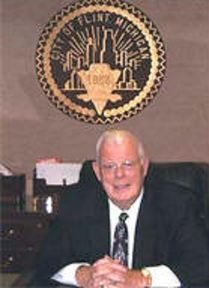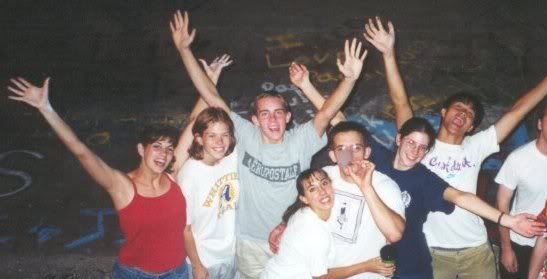The Rock: 2, The Don: 1
EVENT
I miss Flint terribly these days, all the more since Public Enemy No. 1, Don Williamson, our own little W-styled Banana Republican (as opposed to City Council, Lès Mòùntàìn) has met his match, not in his witholding millions in nonprofit funds, laying off city employees, bickering with unions, or refusing to share financial data, but in his desecration of 'the Rock'.
Flintstones will want to read this, Diaspora included.
Outsiders will probably find it intriguing as well.
* * * * *
THE DON ... ... ... ... ... vs. ... ... ... ... ... THE ROCK
 ...
... 
* * * * *
I'd be remiss if I didn't include these gems of Letters to the Editor from the Flint Journal:
MAYOR'S RESPECT HITS ROCK WALL
I would like to personally thank Mayor Don Williamson for his crackdown on graffiti across the city. It is because of his tireless effort that tradition can finally be outlawed and a wonderful new background for "tags" can be made. It is important that we allow those who would make our city look worse the advantage of a plain brown background so their wonderful art form can really pop!
Is this the kind of leadership we can expect? I grew up in Flint and have seen its lack of tradition. "The rock" on 12th and Hammerberg was one of those few traditions. It has now been outlawed. It shows the true lack of understanding and respect our mayor has. People would drive by just to see what was on it that day. Groups would get together and spend the day painting it for something they cared about. It was done in the spirit of fun and tradition.
The mayor didn't even bother to ask us what it meant to us, to our past and future generations. That was a place of happiness. He has labeled our tradition as a crime. Wonderful leadership.
Emerson Jones
and
'ROCK' DECISION A BAD ONE
I'd like to congratulate Mayor Don Williamson on his bold initiative to fine people for painting "the rock" at Hammerberg and 12th, an activity that has gone on as long as I can remember.
Now instead of the occasional gang symbols that get painted on "the rock" and then get painted over within a few hours, we get to look at gang symbols on "the rock" for days on end as the law-abiding citizens are too afraid to cover them up.
Scott Bland
I also must link to the Journal's prominent article on the issue yesterday:
FLINT - Somewhere in the area, someone named Dorothy is celebrating a birthday.
It says so on "the rock," where a "Happy 70th Dorothy" message was written in gold spray-paint - one of many messages visible Tuesday on the concrete block at Hammerberg Road and 12th Street.
In fact, a month after the city coated it with brown paint and threatened to fine anyone who painted on it, the rock is being used as it has for decades - as Flint's unofficial community billboard.
* * * * *
It's easy to dismiss this as undue attention given to a rather frivolous subject... especially given Flint's dire straits in any number of categories. Something larger's at work, however. The Flint Journal usually goes to pains to provide a balanced account of any conspicuous issue, even when such efforts are carried to an absurd extreme. The fact that the Rock has generated so much noise, virtually all of which is one-sided (pro-Rock) is telling.
I don't want to turn this into the five-paragraph essay... the briefest overview of the city's history in the last ten years would encompass continuing deindustrialization and flight, an inability to access the momentum of the 1990s economy, followed by record deficits, late audits and failed budgets.
Financial woes cme to a head in March, 2002 when the deficit topped $40 million and the three-term mayor Woodrow Stanley was recalled, voters acting largely along racial lines.
For a few, brief months Darnell Earley ran the city somewhat smoothly, until a special election produced a range of nominations and disqualifications. These came to an abrupt halt in November, when the state took over, appointing Ed Kurtz as financial manager to resolve the budget crisis, and reducing the mayor (then James Rutherford) and City Council to ceremonial positions. During this receivership, Don Williamson won the mayoral race, again, largely along racial lines, receiving endorsements from 7 out of 9 city council members.
The state receivership ended a couple months ago, with Don Willaimson laying off many city employees and witholding funding from area nonprofits to investigate their activities, in many cases preventing application deadlines from being met.
Don Williamson's most visible efforts to reclaim the city have been in the areas of litter pick up and graffiti cleanup, although he briefly entertained the idea of opening a city-run auto-parts factory, East German style. In light of his recent refusal to supply the city council with budgetary information, a majority of council members are now calling for the mayor's recall. Members of both camps are calling for the others to take polygraph tests on the subject of accepting bribes.
In light of this, and the social breakdown in Flint overall (which doesn't fall along neat age, gender, or racial lines) of high school dropout rates, high crime, poverty, and unemployment, is it any wonder that Flintstones have such little faith in their local instituions, and moreover, that they feel that their relationship to such institutions must be of little relevance to their lives?
* * * * *
In the Jungle, Upton Sinclair argued that crime, poverty, unemployment, corruption, and a lack of adequate workplace standards led to the social breakdown in Chicago's Back of the Yards neighborhood. He argued so extensively, in fact, that his single-mindedness has been criticized as his novel's most salient fault as a social critique. In showing how afflicted his Lithuanian Americans had become, he forgot to notice that they had erected a community in the face of their adversities and that, while this didn't "fix the problem," it did make many people's lives much easier. Credit unions, voting blocks, widespread church and union participation all made a huge difference.
Flintstones feel a variety of emotions for their city, and see her from a variety of perspectives. Many of the most powerful and pervasive identities are perceived in the Rock, and such an communal outlet isn't insignificant.
Frustration, love, grief, anger, and joy poured out on the Rock as graffiti, birthday wishes, political commentary, shout outs, memorials, advertisements, and on and on and on and on, covering the massive surface for decades.
The Rock encouraged a work ethic; painting took several people hours. It was an opportunity to be seen. Police and autoworkers honked at you in the 3 AM as they passed and thousands saw the Rock daily as they drove by on I-69. The Rock offered a nonviolent outlet... if you didn't like what someone posted, you didn't swear, you didn't mug them or jump them or shoot them or chase them... you got paint, and painted your own message. Unlike Flint's mayoral elections, has not been tarnished by systematic or wide-reaching racism... the racial discourse here has largely been productive. Unlike the factories around it the Rock it hasn't emptied and fallen apart or been imploded with dynamite.
But most importantly, the Rock, unlike many striking developments in my hometown, has gotten steadily better over the last thirty years.
Until the mayor had it stripped last month.
Already, residents are shirking the restrictions. The "$1000 fine" signs have already been stolen, both of them. The Rock is shimmering in paint. It will rise again... it affords us a glimpse of the phoenix.
If Don Williamson loses his reelection bid (one can only hope), he may well find his loss written on the Rock.

from the Black Box Underground website:
Marcy Sheldon, Annie Hartranft, Josh Aldred, Lindsay Crawford, Victor Galea, Elizabeth Jordan and Tony Du give a cheer after painting the "block" graduation, 1999.
I know. I saw. I was there.
~ Connor

0 Comments:
Post a Comment
Subscribe to Post Comments [Atom]
<< Home